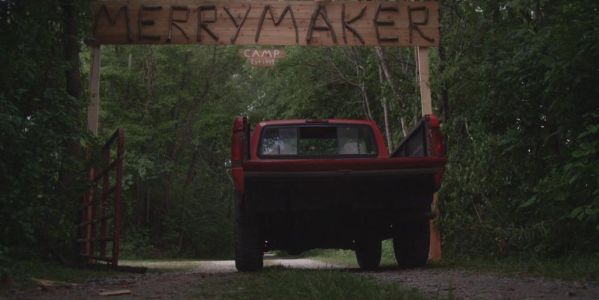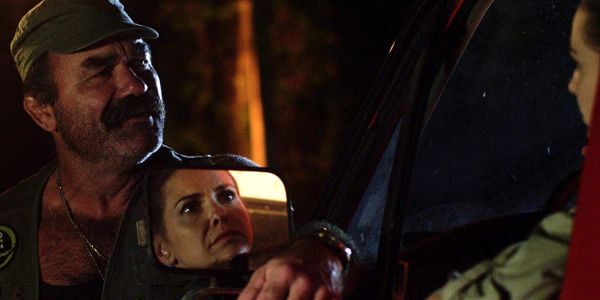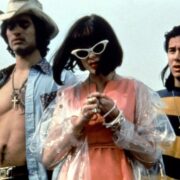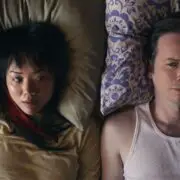ANIMAL AMONG US: The Real Monster Was Boredom All Along

Born in 1997, I'm trying to do my best with…
Many people, myself included, would argue that we’re amidst a golden age for mainstream horror movies. Money is being tossed throughout the genre; at big budget projects like the IT duology, or smaller and more experimental films like The Lighthouse. Indie darlings like Get Out and Us are finding wide financial success. Hereditary and Midsommar operate and evolve within the confines of the genre, coming up with new and exciting combinations of terror, despair, and catharsis like medieval emotional alchemy.
John Woodruff‘s Animal Among Us ignores all the lessons learned in the last few years. Generic in all the worst ways, this film is poorly executed in the most basic sense of the word. Additionally, it also uncritically displays the racism, sexism and ableism common throughout early 2000s horror movies. When it does try to do something clever, which isn’t actually very clear, it utterly fails. The end result is a film whose only value is to highlight just how clever and interesting the golden age really has been, which, I guess, is a good thing.
Plots are supposed to make sense, right?
Animal Among Us‘ story is largely focused around Merrymaker Camp Grounds; fifteen years ago two girls were killed on the premises, resulting in the the financial tanking of the camp. Roland Baumgarner, played by Christian Oliver, capitalized off of the tragedy by writing an account of those tragic events. What spelled literary success for Roland also compounded the financial woes of the camp. Fifteen years later Larisa Oleynik’s and Christine Donlon’s Anita and Poppy Bishop, daughters of the original owner, have spent a lot of time re-branding and reinvesting in the campgrounds. The grand reopening is fast approaching.

Unfortunately, whatever killed those girls fifteeen years ago seems to still be out there. Before long our whole cast, rounded out by Burl, the Bishop sister’s estranged step father and walking inferiority complex, and a bigfoot obsessed reporter simply called The Reporter on imdb, and Whitney Davis’ Lupita De La Rosa. The plot is, overall, poorly conceived. There is a bevy of little details that don’t really make sense. While, in small amounts this isn’t really a problem, there are so many that the whole thing collapses.
The Men Are The Worst
Burl and Lupita are, among an uninspiring cast, the most aggravating. Don Frye gives a fine performance as wannabe veteran Burl, but the character himself is uninteresting. His relationship with his step daughter Poppy is strange; it’s too-flirtatious, and never really fleshed out at all. So, it seems he just wants to sleep with his step daughter? In addition to being sexually aggressive, he’s also racist towards Lupita. The character is utterly irredeemable; its unclear if that was intentional, or if the intended audience is supposed to find his gruffness charming. Either way, I found him frustrating.

Both men in this film are utterly sex crazed, with Roland having at least two, probably three sexual partners. To his credit, Roland seems fairly guilty about sleeping with everyone. Burl in contrast comes across as a nasty old man. Lupita herself, the film’s only non-white person, is unsurprisingly paper thin; she has zero backstory and no agency, mostly serving as problem that the other, white, characters must deal with.
The Bishop sisters are as close to fleshed out characters as Animal Among Us has. Anita is willing to do whatever she can to protect the campgrounds, and Poppy just wants to make a life for herself. When I say the Bishop sisters are the most competent of the bunch, this is of course a relative term. When every character is shallow as a small groove in the road, a puddle sticks out. Both Anita and Poppy never really articulate why they feel the way that they do, instead opting to just exclaim their feelings whenever seems appropriate.
Our male lead, Roland Baumgarner, is a fairly inactive character. Early on he receives a letter from the Bishop girls’ mother, asking him to attend the grand reopening of the campgrounds. His wife suggests he doesn’t, but he ignores her and heads there anyway. That is an exhaustive list of the choices he makes throughout the film.

In fact, Roland’s inaction ties into something somewhat clever that the film may be attempting to do. As the film progresses, it becomes increasingly unclear who the protagonist is. It seems like it’s probably Roland. At times it seems like it may be Anita, but that’s mostly because she’s the only one actually making decisions at any one time. It’s totally possible that this wasn’t actually intentional, and that Roland is simply a badly written protagonist. Either way, if it was trying to be clever, it didn’t work. If it wasn’t trying, then there’s not much to say.
Animal Among Us: Concluding Thoughts
Animal Among Us doesn’t really have what you’d call themes. Sex, and how problematic male sexuality can be, is a motif throughout. No stance regarding it is articulated, the film seeming satisfied with acknowledging its existence. In fact, the film feels like it was written by someone who cheated on his wife. He was then caught, and made to write the movie was penance, but actually didn’t regret it, so there’s no reflection or meaningful thought behind it. The nature of the monster may be an attempt to say something, but the reveal is just random and in poor taste.
What else is there to say about Animal Among Us? It looks fine, the lighting is good. Performances range from generic and uninteresting to just bad. That’s mostly the writing’s fault, though. The characters are undeveloped and the plot is sparse and uninteresting. I would say there’s nothing going on under the hood, but frankly, there isn’t even a hood. It’s the cinematic equivalent of tying some tires together, rolling it down a hill, and calling it a car.
It feels like a bad homage early 2000s slasher flicks – which actual 2000s slasher is your favorite?
Animal Among Us released on November 19th on VOD.
Does content like this matter to you?
Become a Member and support film journalism. Unlock access to all of Film Inquiry`s great articles. Join a community of like-minded readers who are passionate about cinema - get access to our private members Network, give back to independent filmmakers, and more.
Born in 1997, I'm trying to do my best with this life thing. I have a Bachelor of Arts in English and Anthropology. I cry at musicals. I'm going to film school now. I'm still unsure if Donnie Darko is too edgy, or actually not edgy enough. I've been writing about film for three years. I'm still waiting for those lambs to stop screaming.













